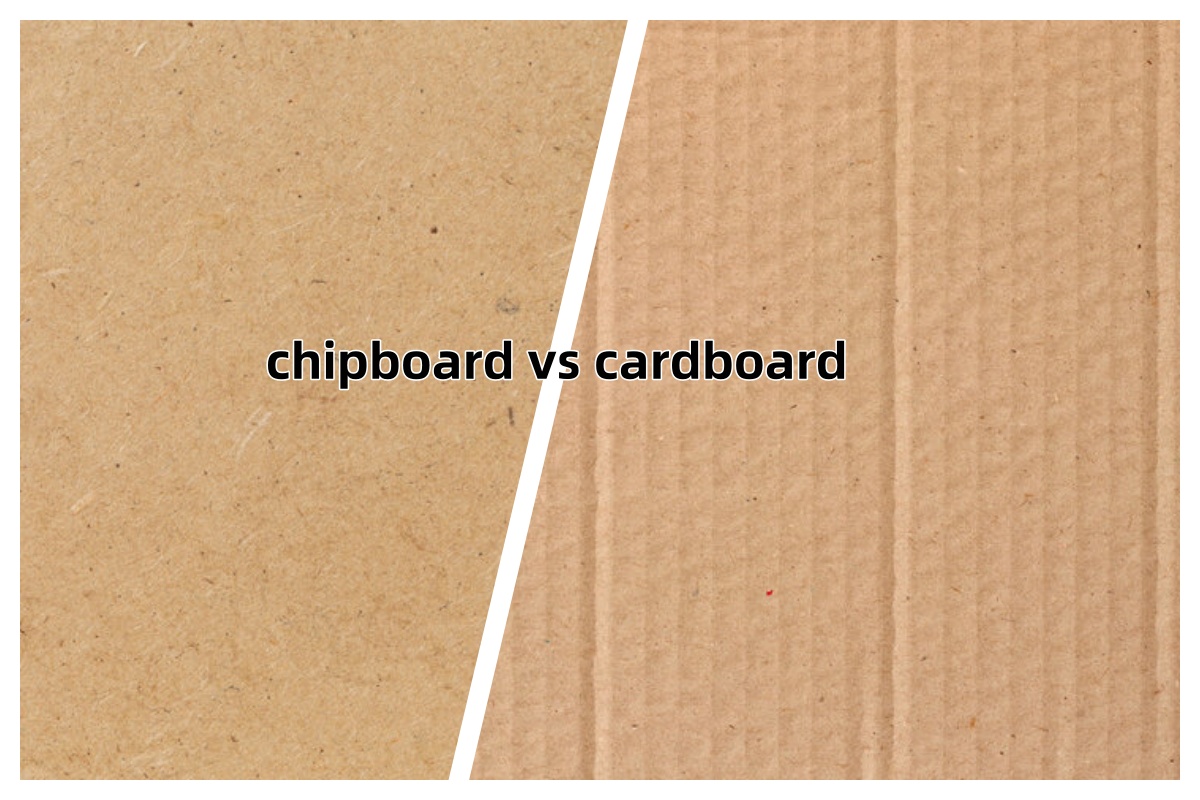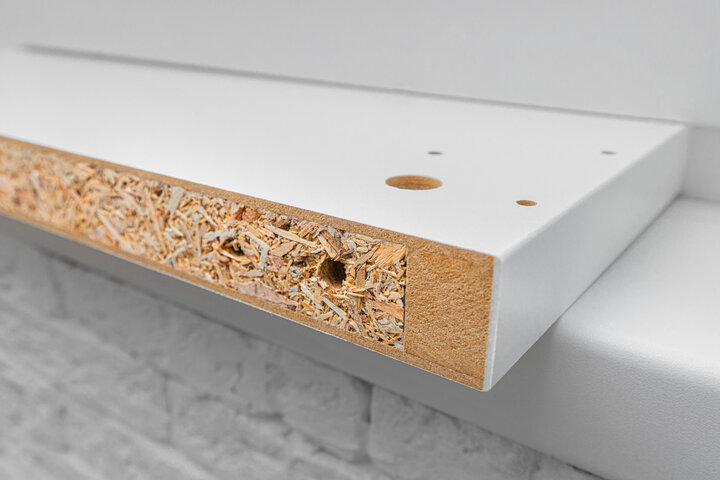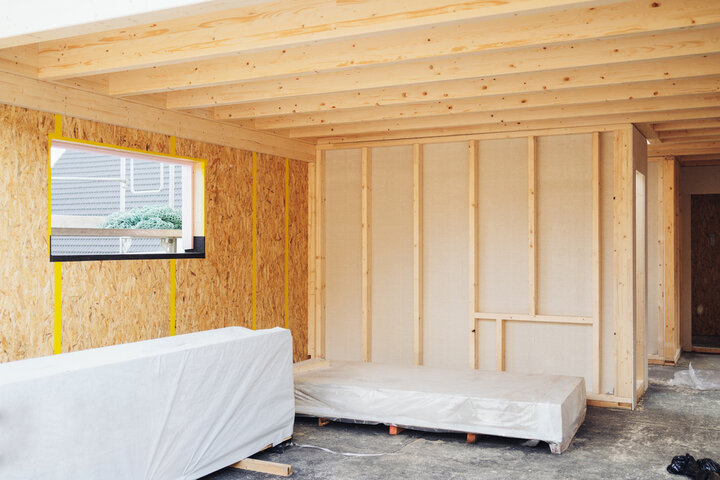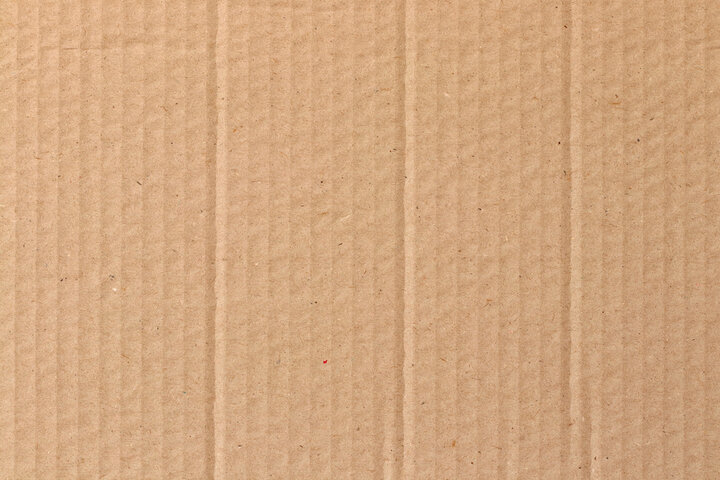
Packaging matters. It protects products, enhances branding, and influences costs. But with so many materials available, choosing the right one is tricky.
Chipboard and cardboard are two common options, but they serve different purposes. Understanding their strengths, costs, and sustainability is crucial.
In this post, we’ll compare chipboard and cardboard, their durability, applications, and environmental impact. By the end, you’ll know which one fits your needs best.
What is Chipboard?
Definition and Composition
Chipboard, sometimes referred to as paperboard, is a dense material crafted primarily from recycled paper and cardboard materials. Unlike what its name might suggest, chipboard isn't made from wood chips (though a variant called particle board is). Instead, it consists of compressed paper fibers formed into a single-layer, lightweight yet durable paper stock that offers excellent structural integrity for its weight.

Manufacturing Process
The production of chipboard involves collecting recycled paper materials, which are then pulped, pressed, and dried under controlled conditions. These materials are compressed under high pressure and heat to create sheets of varying thicknesses. This process results in a uniformly dense product with a smooth surface, making it ideal for printing and customization.
General Characteristics
Chipboard offers several distinctive properties that make it valuable for various applications:
| Characteristic | Description |
| Density | Higher than cardboard, providing better rigidity |
| Surface | Smooth and consistent, excellent for printing |
| Weight | Lightweight yet sturdy |
| Moisture resistance | Limited without additional treatment |
| Environmental impact | Eco-friendly (made from recycled materials) |
| Cost | Generally more affordable than specialty boards |
Common Uses of Chipboard
Chipboard's versatility makes it suitable for numerous applications across different industries:

Packaging (Cosmetics, Food, Electronics)
Chipboard serves as a guardian for delicate items, from fragile food products to luxury cosmetics and sensitive electronics. Its smooth surface enhances brand presentation while providing necessary protection.
Stationery and Office Supplies
Backing for notepads and notebooks
Envelope stiffeners
File folders and dividers
Business cards and presentation materials
Board Games and Puzzles
The material's robustness makes it ideal for game boards and puzzle pieces that must withstand frequent handling while maintaining structural integrity.
Furniture and Construction
When treated appropriately, chipboard serves as backing material for cabinets, shelves, and other furniture pieces, offering stability without excessive weight.
Creative and Crafting Projects
Chipboard's smooth surface and die-cutting capabilities make it a favorite among crafters for scrapbooking elements, custom signage, and decorative frames.
What is Cardboard?
Definition and Composition
Cardboard is a heavy-duty paper-based material used primarily for packaging and storage. It is composed of cellulose fibers from trees or recycled paper products. Depending on its construction and intended use, cardboard can range from thin, flexible sheets to thick, rigid structures.

Types of Cardboard
Cardboard comes in different forms, each serving distinct purposes. The two most common types are:
1. Corrugated Cardboard
Corrugated cardboard consists of multiple layers:
Two flat linerboards sandwiching a fluted (wavy) middle layer.
The fluting provides cushioning and strength, making it ideal for shipping and heavy-duty applications.
Often used in shipping boxes, product packaging, and structural applications.
2. Paperboard (Solid Cardboard)
Paperboard, also called solid cardboard, is a single-layer material:
Thinner and more flexible than corrugated cardboard.
Commonly used for cereal boxes, shoe boxes, and lightweight packaging.
Provides a smooth surface, making it perfect for high-quality printing and branding.
Manufacturing Process
Cardboard production follows these key steps:
Pulping – Wood chips or recycled paper are processed into a slurry.
Sheet Formation – The pulp is pressed into sheets and dried.
Layering (for corrugated cardboard) – A fluted layer is sandwiched between linerboards.
Cutting and Shaping – The sheets are cut into various shapes for boxes and packaging.
Printing and Coating – Some cardboard undergoes printing, lamination, or waterproofing for enhanced durability.
General Characteristics
Cardboard offers versatility, strength, and cost-efficiency. Below is a breakdown of its key features:
| Property | Description |
| Durability | Corrugated cardboard is highly resistant to impact and compression. |
| Lightweight | Despite its strength, cardboard is light, reducing shipping costs. |
| Recyclability | Made from recycled paper and biodegradable, making it eco-friendly. |
| Printability | Smooth surface allows for high-quality branding and packaging design. |
| Moisture Resistance | Standard cardboard absorbs moisture, but coated options are available. |
Common Uses of Cardboard
1. Shipping and E-commerce Packaging

Corrugated cardboard is the go-to material for shipping boxes.
Used in online retail and logistics for its durability and cost-effectiveness.
Provides cushioning and protection for fragile items.
2. Moving and Storage
Sturdy cardboard boxes help transport household goods safely and efficiently.
Used for archival storage of documents and office supplies.
Easy to label, stack, and recycle after use.
3. Retail Displays and Branding
Custom-designed cardboard store displays and product packaging enhance brand visibility.
Used for point-of-purchase (POP) displays in retail stores.
Paperboard boxes are widely used for consumer goods packaging.
4. Electronics Protection
Corrugated boxes with protective inserts shield electronics from shocks and static electricity.
Used for TVs, laptops, mobile phones, and fragile tech components.
5. Temporary Furniture and Structures
Some furniture and pop-up installations use reinforced cardboard.
Sustainable option for exhibitions, trade shows, and eco-friendly furniture designs.
Comparison: Chipboard vs. Cardboard
When choosing between chipboard and cardboard, it's important to consider their strength, durability, cost, printability, and sustainability. Both materials serve different packaging and structural needs, making them suitable for specific applications. Below is a detailed comparison to help you decide which material is best for your needs.
1. Strength and Durability
| Feature | Chipboard | Cardboard |
| Density | Denser and more rigid | Lightweight but less sturdy |
| Durability | Resistant to bending but prone to moisture damage | Stronger with corrugation for impact resistance |
| Best Use | Ideal for flat and firm packaging | Best for shipping and cushioning |
Chipboard: Compact and stiff, making it ideal for rigid packaging but susceptible to damage under excessive force.
Cardboard: More flexible and impact-resistant, making it better for shipping boxes that need to absorb shocks.
2. Weight and Space Efficiency
Chipboard: Compact and denser, which is great for stacking and saving space.
Cardboard: Lighter and easier to handle, making it a top choice for bulk shipping and transportation.
3. Moisture Resistance
Chipboard: Absorbs water quickly, which can weaken its structure unless coated with a protective layer.
Cardboard: Can be treated with water-resistant coatings for use in damp environments.
4. Printability and Customization
| Feature | Chipboard | Cardboard |
| Surface | Smooth, high-quality for detailed printing | Good for branding and bold designs |
| Customization | Best for luxury and retail packaging | More adaptable for different shapes and sizes |
Chipboard: Preferred for high-end packaging where detailed branding and printing are important.
Cardboard: Ideal for shipping boxes, retail displays, and branding flexibility.
5. Cost Comparison
Chipboard: Higher upfront cost, but long-term durability can make it cost-effective.
Cardboard: Cheaper and widely available, making it the go-to choice for budget packaging.
6. Sustainability and Environmental Impact
| Factor | Chipboard | Cardboard |
| Material | Made from recycled paper | Fully recyclable and biodegradable |
| Eco-Friendliness | Sustainable, but harder to recycle in some cases | More widely recycled and compostable |
7. Structural Integrity in Packaging
Chipboard: Stiff and strong, commonly used in electronics, cosmetics, and luxury goods packaging.
Cardboard: Provides cushioning and impact resistance, making it the better option for shipping.
8. Suitability for Various Applications
| Application | Chipboard | Cardboard |
| Retail Packaging | ✔️ Best for premium products | ✔️ Used in cost-effective displays |
| Shipping Boxes | ❌ Not ideal | ✔️ Best choice for protection and transport |
| Creative Uses | ✔️ Ideal for crafts and DIY projects | ✔️ Common for recyclable, temporary structures |
Choosing Between Chipboard and Cardboard
Selecting the right packaging material is crucial for product protection, branding, and cost efficiency. Both chipboard and cardboard serve distinct purposes, making it essential to evaluate factors like product characteristics, budget, sustainability, and industry needs before making a decision.
Factors to Consider
When deciding between chipboard and cardboard, consider these key factors:
1. Product Type (Fragility, Weight, Size)
Chipboard: Best for lightweight, rigid, and non-fragile products like cosmetics, stationery, and electronics packaging.
Cardboard: Ideal for heavier, fragile, or high-impact shipments where protection against external pressure is necessary.
2. Budget Constraints
Chipboard: Slightly more expensive due to its higher density and quality finish.
Cardboard: Cost-effective, widely available, and preferred for large-scale shipping and bulk packaging.
3. Environmental Concerns
| Feature | Chipboard | Cardboard |
| Material | Made from recycled fibers | Made from virgin or recycled pulp |
| Recyclability | Can be recycled, but requires special processing in some cases | Fully recyclable and biodegradable |
| Sustainability | Eco-friendly alternative for luxury packaging | Commonly recycled and composted |
4. Branding and Aesthetics
Chipboard: Smooth surface, excellent for premium printing, embossing, and high-end product presentation.
Cardboard: Versatile for branding, ideal for e-commerce, shipping, and product display boxes.
Best Use Cases
When to Use Chipboard
✔ Luxury and premium packaging
✔ Retail display packaging for cosmetics, electronics, and food products
✔ Creative and artistic applications like crafting and custom product design
✔ Eco-conscious brands that want recycled packaging
When to Use Cardboard
✔ Shipping and logistics for fragile, heavy, or bulk products
✔ E-commerce packaging that requires cost-effective solutions
✔ Storage boxes for moving, archiving, and warehouse applications
✔ Temporary structures such as pop-up displays and exhibition setups
Industry-Specific Recommendations
1. Retail Packaging
Chipboard: Used for premium product boxes, like cosmetics, perfumes, and specialty foods.
Cardboard: Common in point-of-sale (POS) displays and bulk product cartons.
2. Shipping and Logistics
Chipboard: Not ideal for heavy-duty shipping, but useful for inner packaging and dividers.
Cardboard: Best for shipping boxes and protective outer layers.
3. Consumer Goods
Chipboard: Perfect for rigid, lightweight items like board games, electronics, and stationery.
Cardboard: Suitable for household items, food packaging, and disposable products.
4. Creative and Crafting Industries
Chipboard: Preferred for DIY projects, scrapbooking, and artistic designs.
Cardboard: Best for custom printing, sustainable crafts, and eco-friendly furniture.
Conclusion
Chipboard and cardboard serve different purposes. Chipboard is denser and smoother, ideal for premium packaging and creative projects. Cardboard is lightweight and durable, making it perfect for shipping and bulk packaging.
Choosing the right material depends on product needs, budget, and sustainability goals. Chipboard is best for rigid, high-end applications, while cardboard excels in protective and cost-effective packaging.
Both materials are eco-friendly and recyclable. Opting for sustainable packaging helps reduce waste and environmental impact, making a positive contribution to the planet.
FAQs
Q: Is chipboard considered cardboard?
A: According to industry terminology, chipboard is not technically cardboard but both are paper-based materials. Cardboard is a general term for thick paper-based materials that includes both corrugated boards and chipboard. The terminology can be confusing as these words are often used interchangeably. Some consider chipboard and cardboard the same material, while others distinguish them as separate products with different properties.
Q: What is the main advantage of using chipboard?
A: Chipboard's primary advantage is its superior printability due to its consistently smooth surface that enhances the sharpness and vibrancy of designs and labels. This makes it ideal for high-end packaging that requires premium visual presentation. Additionally, chipboard is eco-conscious (made from recycled materials), lightweight, and dense with consistent thickness, providing good structural integrity while minimizing material use.
Q: Are paperboard and chipboard the same?
A: Yes, chipboard and paperboard are essentially the same material. As stated in the article, "Chipboard (or paperboard) is a single-layer, lightweight, durable paper stock." Both terms refer to a single-layer sheet material made from compressed paper fibers. The terminology varies by industry and region, but they describe the same product—a rigid, dense paper-based material used for packaging and structural applications.
Q: What do you use chipboard for?
A: Chipboard is commonly used for food, cosmetic, and electronics packaging; stationery products like notebook backing and folders; board games and puzzles; dividers and inserts in packaging; point-of-purchase retail displays; backing in blister packaging; tubes for storing posters; and craft projects like scrapbooking. Its smooth printable surface and structural rigidity make it ideal for applications requiring both strength and aesthetic appeal.
Q: Is chipboard better than cardboard?
A: Neither material is universally "better"—each has advantages for different applications. Chipboard excels for premium packaging, printability, and lightweight items requiring rigidity. Cardboard (especially corrugated) provides superior protection for shipping, cushioning for fragile items, and durability for heavy products. The choice depends on specific needs including product type, shipping requirements, budget constraints, and desired aesthetic appearance.
Q: What are the disadvantages of chipboard?
A: Chipboard's main disadvantages include reduced durability compared to corrugated cardboard, especially for heavy-duty applications; poor moisture resistance without special treatment (it absorbs water and warps easily); heavier weight than cardboard (increasing shipping costs); and limited cushioning properties. While recyclable, some manufacturing processes can be resource-intensive, potentially offsetting some environmental benefits despite its recycled content.





























